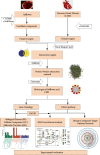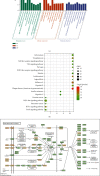A Network Pharmacology Study to Explore the Underlying Mechanism of Safflower (Carthamus tinctorius L.) in the Treatment of Coronary Heart Disease
- PMID: 35607519
- PMCID: PMC9124127
- DOI: 10.1155/2022/3242015
A Network Pharmacology Study to Explore the Underlying Mechanism of Safflower (Carthamus tinctorius L.) in the Treatment of Coronary Heart Disease
Abstract
Safflower has long been used to treat coronary heart disease (CHD). However, the underlying mechanism remains unclear. The goal of this study was to predict the therapeutic effect of safflower against CHD using a network pharmacology and to explore the underlying pharmacological mechanisms. Firstly, we obtained relative compounds of safflower based on the TCMSP database. The TCMSP and PubChem databases were used to predict targets of these active compounds. Then, we built CHD-related targets by the DisGeNET database. The protein-protein interaction (PPI) network graph of overlapping genes was obtained after supplying the common targets of safflower and CHD into the STRING database. The PPI network was then used to determine the top ten most significant hub genes. Furthermore, the DAVID database was utilized for the enrichment analysis on Gene Ontology (GO) and Kyoto Encyclopedia of Genes and Genomes (KEGG). To validate these results, a cell model of CHD was established in EAhy926 cells using oxidized low-density lipoprotein (ox-LDL). Safflower was determined to have 189 active compounds. The TCMSP and PubChem databases were used to predict 573 targets of these active compounds. The DisGeNET database was used to identify 1576 genes involved in the progression of CHD. The top ten hub genes were ALB, IL6, IL1B, VEGFA, STAT3, MMP9, TLR4, CCL2, CXCL8, and IL10. GO functional enrichment analysis yielded 92 entries for biological process (BP), 47 entries for cellular component (CC), 31 entries for molecular function (MF), and 20 signaling pathways, which were obtained from KEGG pathway enrichment screening. Based on these findings, the FoxO signaling pathway is critical in the treatment of CHD by safflower. The in vitro results showed that safflower had an ameliorating effect on ox-LDL-induced apoptosis and mitochondrial membrane potential. The western blot results showed that safflower decreased Bax expression and acetylation of FoxO1 proteins while increasing the expression of Bcl-2 and SIRT1 proteins. Safflower can be used in multiple pathways during CHD treatment and can exert anti-apoptotic effects by regulating the expression of Bax, Bcl-2, and SIRT1/FoxO1 signaling pathway-related proteins.
Copyright © 2022 Qingwen Meng et al.
Conflict of interest statement
The authors declare that the research was conducted in the absence of any commercial or financial relationships that could be construed as potential conflicts of interest.
Figures








Similar articles
-
The Cardioprotective Effects and Mechanisms of Astragalus-Safflower Herb Pairs on Coronary Heart Disease Identified by Network Pharmacology and Experimental Verification.Front Biosci (Landmark Ed). 2023 May 22;28(5):94. doi: 10.31083/j.fbl2805094. Front Biosci (Landmark Ed). 2023. PMID: 37258471
-
Network pharmacology exploration reveals a common mechanism in the treatment of cardio-cerebrovascular disease with Salvia miltiorrhiza Burge. and Carthamus tinctorius L.BMC Complement Med Ther. 2020 Nov 19;20(1):351. doi: 10.1186/s12906-020-03026-y. BMC Complement Med Ther. 2020. PMID: 33213432 Free PMC article.
-
Exploring the pharmacological components and effective mechanism of Mori Folium against periodontitis using network pharmacology and molecular docking.Arch Oral Biol. 2022 Jul;139:105391. doi: 10.1016/j.archoralbio.2022.105391. Epub 2022 Mar 21. Arch Oral Biol. 2022. PMID: 35430443
-
[Mechanism of Danggui Sini Decoction in treatment of primary dysmenorrhea based on network pharmacology and molecular docking].Zhongguo Zhong Yao Za Zhi. 2021 Feb;46(4):855-864. doi: 10.19540/j.cnki.cjcmm.20201104.401. Zhongguo Zhong Yao Za Zhi. 2021. PMID: 33645090 Chinese.
-
Exploration of the mechanism of Zisheng Shenqi decoction against gout arthritis using network pharmacology.Comput Biol Chem. 2021 Feb;90:107358. doi: 10.1016/j.compbiolchem.2020.107358. Epub 2020 Aug 8. Comput Biol Chem. 2021. PMID: 33243703 Review.
Cited by
-
Safflower CtFLS1-Induced Drought Tolerance by Stimulating the Accumulation of Flavonols and Anthocyanins in Arabidopsis thaliana.Int J Mol Sci. 2024 May 19;25(10):5546. doi: 10.3390/ijms25105546. Int J Mol Sci. 2024. PMID: 38791581 Free PMC article.
-
Exploring the mechanism of action bitter melon in the treatment of breast cancer by network pharmacology.World J Exp Med. 2023 Dec 20;13(5):142-155. doi: 10.5493/wjem.v13.i5.142. eCollection 2023 Dec 20. World J Exp Med. 2023. PMID: 38173546 Free PMC article.
References
-
- Jin Y., Wu L., Tang Y., et al. UFLC-Q-TOF/MS based screening and identification of the metabolites in plasma, bile, urine and feces of normal and blood stasis rats after oral administration of hydroxysafflor yellow A. Journal of Chromatography B . 2016;1012-1013:124–129. doi: 10.1016/j.jchromb.2016.01.023. - DOI - PubMed
LinkOut - more resources
Full Text Sources
Research Materials
Miscellaneous

